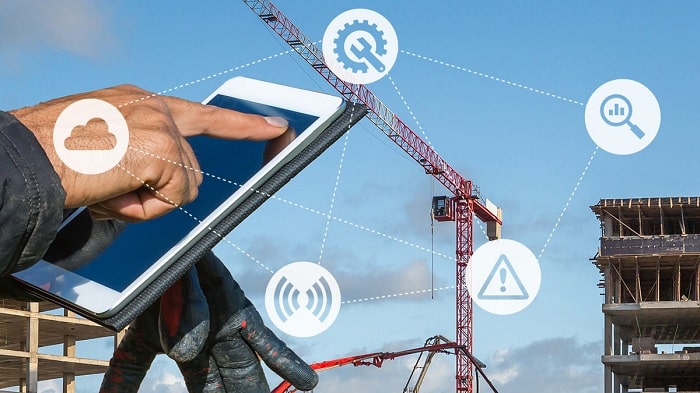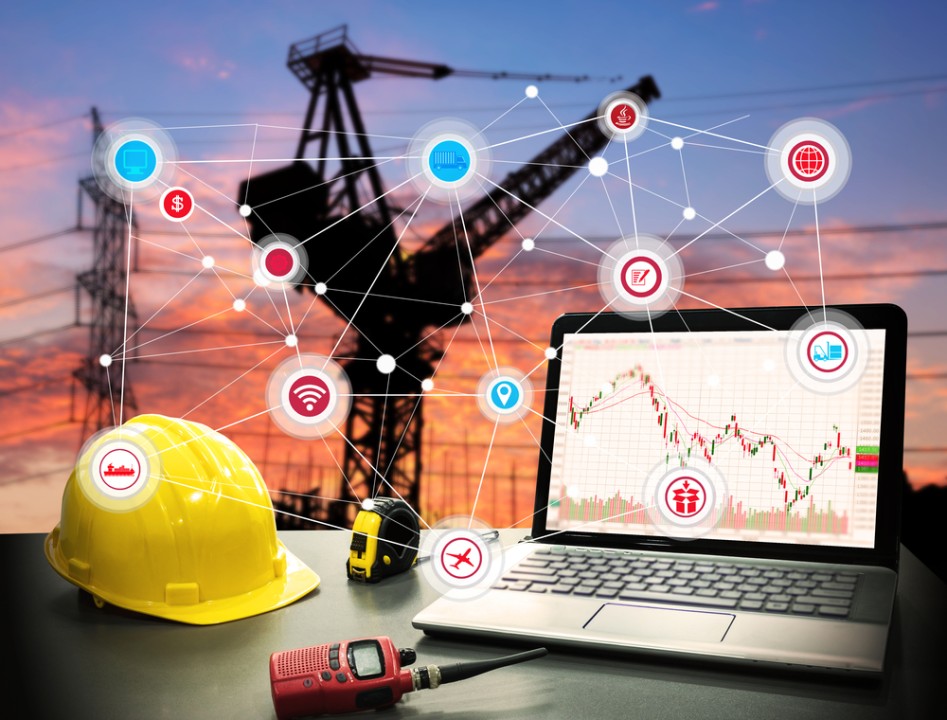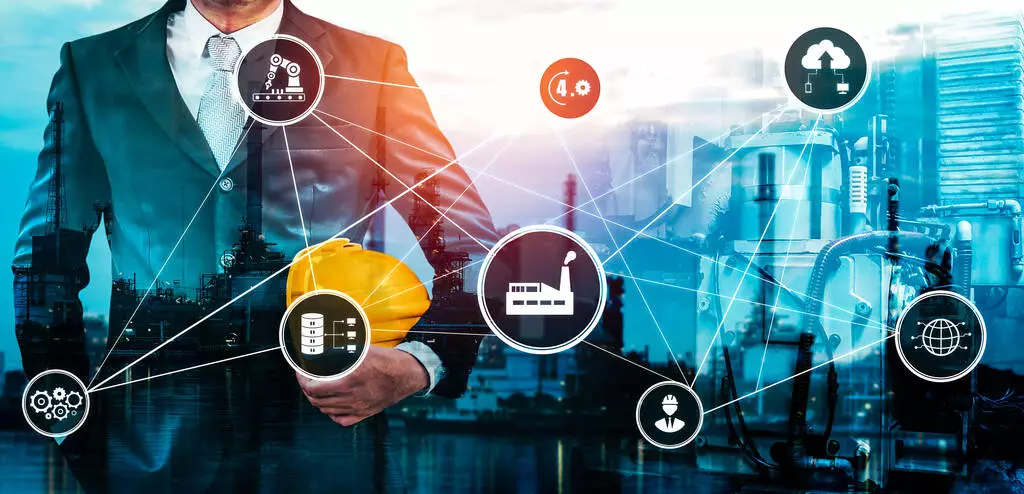IoT in Construction. Benefits, Applications, Challenges, and Limitations.
In an era marked by rapid technological advancements, the construction industry stands at the forefront of innovation, propelled by transformative technologies like the Internet of Things (IoT). IoT in construction industry represents a paradigm shift, revolutionizing traditional practices by integrating interconnected devices and sensors to optimize processes, enhance safety, and drive productivity. This article offers an in-depth analysis of IoT in construction, delving into its multifaceted landscape, and exploring its myriad benefits, diverse applications, formidable challenges, and inherent limitations while highlighting its pivotal role in modern construction project management.
Table of Contents
Understanding IoT in Construction
IoT in construction industry epitomizes the convergence of digitalization and construction, encompassing a vast array of sensor-equipped devices, machinery, and equipment interconnected through networks. These IoT-enabled devices gather real-time data on various aspects of construction projects, including environmental conditions, equipment performance, worker activities, and site logistics. Leveraging advanced analytics, cloud computing, and machine learning algorithms, this data is processed, analyzed, and translated into actionable insights, empowering construction stakeholders to make informed decisions, optimize workflows, and mitigate risks proactively.

Applications of IoT in Construction
Smart Site Monitoring and Management:
IoT sensors deployed across construction sites facilitate comprehensive monitoring of critical parameters such as temperature, humidity, air quality, and structural integrity. Real-time data insights enable proactive risk management, early detection of potential hazards, and adherence to stringent safety standards, thereby fostering a safer and more secure work environment.
Asset Tracking and Management:
The integration of IoT technology enables precise tracking and management of construction assets, ranging from tools and machinery to materials and personnel. RFID tags, GPS trackers, and sensor-based systems provide accurate location data, enhancing inventory control, minimizing asset loss, and optimizing resource allocation, thereby maximizing operational efficiency and cost-effectiveness.
Predictive Maintenance:
IoT-enabled predictive maintenance systems monitor equipment performance and operational metrics in real-time, leveraging predictive analytics algorithms to anticipate potential failures and malfunctions. By identifying maintenance needs before they escalate into costly breakdowns, IoT-driven predictive maintenance strategies minimize downtime, extend asset lifespan, and optimize maintenance schedules, thereby ensuring optimal equipment performance and reliability.
Enhanced Worker Safety:
Wearable IoT devices, such as smart helmets, vests, and wristbands, equipped with sensors and biometric monitoring capabilities, enhance worker safety on construction sites. These devices detect and alert against potential accidents, monitor vital signs, and ensure compliance with safety protocols, thereby reducing the risk of workplace injuries and fatalities and fostering a culture of safety and well-being among construction personnel.
Remote Project Management:
IoT platforms empower project managers to remotely monitor and manage construction projects in real time, regardless of geographical constraints. By providing access to critical project data, progress reports, and performance metrics, IoT-enabled remote project management solutions facilitate better decision-making, improved communication, and enhanced collaboration among project stakeholders, thereby accelerating project timelines and optimizing resource utilization.

Benefits of IoT in Construction
Improved Efficiency and Productivity:
IoT-driven automation, data analytics, and optimization algorithms streamline construction processes, minimize manual intervention, and maximize operational efficiency. By providing real-time visibility into project workflows, resource utilization, and performance metrics, IoT in construction enables construction stakeholders to identify inefficiencies, eliminate bottlenecks, and optimize project schedules, thereby enhancing productivity and profitability.
Enhanced Safety and Risk Mitigation:
Real-time monitoring of environmental conditions, equipment performance, and worker activities enables proactive risk management and accident prevention. By providing early warning alerts and actionable insights, IoT technology helps construction stakeholders identify and mitigate potential safety hazards, thereby reducing the incidence of workplace accidents, minimizing liability risks, and fostering a safer and more secure work environment.
Cost Optimization and Asset Management:
IoT-enabled asset tracking, predictive maintenance, and inventory management solutions minimize asset loss, theft, and unnecessary expenditures. By providing real-time visibility into asset location, condition, and usage patterns, IoT technology helps construction stakeholders optimize resource allocation, reduce inventory carrying costs, and extend asset lifespan, thereby maximizing cost savings and operational efficiency.
Data-Driven Decision Making:
IoT-generated data provides valuable insights into construction processes, performance metrics, and project workflows, enabling construction stakeholders to make informed, data-driven decisions. By leveraging advanced analytics, machine learning, and predictive modeling techniques, IoT technology helps construction stakeholders identify trends, patterns, and correlations in large datasets, thereby enabling proactive problem-solving, strategic planning, and optimized decision-making, leading to better project outcomes and improved profitability.
Sustainability and Environmental Compliance:
IoT technology facilitates the monitoring of environmental parameters, energy consumption, and carbon emissions, enabling construction stakeholders to promote sustainable construction practices and ensure compliance with regulatory standards. By providing real-time visibility into environmental impact metrics and resource usage patterns, IoT technology helps construction stakeholders optimize resource utilization, minimize waste generation, and reduce carbon footprint, thereby contributing to environmental conservation efforts and promoting sustainable development practices.

Challenges and Limitations of IoT in Construction
Data Security and Privacy Concerns:
The proliferation of interconnected devices and data exchange networks increases the vulnerability of construction systems to cybersecurity threats, data breaches, and privacy violations. Protecting sensitive construction data, securing IoT devices, and ensuring compliance with data privacy regulations pose significant challenges for construction stakeholders, requiring robust cybersecurity measures, encryption protocols, and access controls to safeguard critical data assets and mitigate security risks.
Interoperability and Integration Issues:
Integrating diverse IoT devices, sensors, and platforms from multiple vendors often leads to compatibility issues, interoperability challenges, and integration complexities. Ensuring seamless communication and data exchange among interconnected systems requires standardized protocols, open APIs, and robust integration frameworks, thereby facilitating interoperability, scalability, and flexibility in IoT deployment across diverse construction projects and environments.
Reliability and Connectivity Issues:
Construction sites often encounter connectivity challenges due to remote locations, limited network coverage, and harsh environmental conditions. Maintaining reliable connectivity for IoT devices, ensuring uninterrupted data transmission, and addressing latency issues pose operational challenges for construction stakeholders, requiring resilient network infrastructure, redundant communication channels, and IoT gateways to ensure seamless connectivity and data exchange in dynamic construction environments.
Complexity and Scalability:
Deploying and managing IoT infrastructure in large-scale construction projects requires significant investment, expertise, and resources. Addressing the complexity of IoT implementation, managing heterogeneous device ecosystems, and scaling up solutions across diverse projects pose practical challenges for construction stakeholders, requiring comprehensive planning, strategic investments, and collaboration among stakeholders to ensure successful IoT deployment and adoption in construction.
Skill Gaps and Training Needs:
Leveraging IoT technology effectively necessitates a skilled workforce proficient in data analytics, cybersecurity, and IoT management. Bridging skill gaps, providing comprehensive training, and fostering digital literacy among construction professionals are essential for successful IoT adoption in construction, requiring investment in training programs, certification courses, and talent development initiatives to build a competent workforce capable of leveraging IoT technology to its full potential and driving digital transformation in the construction industry.

Conclusion
IoT in construction holds immense promise as a transformative technology, offering unprecedented opportunities to enhance efficiency, safety, and sustainability across construction projects. By harnessing the power of real-time data insights, automation, and predictive analytics, IoT technology enables construction stakeholders to optimize workflows, mitigate risks, and drive innovation, thereby transforming traditional construction practices and driving sustainable growth in the construction industry.
Despite facing challenges such as data security, interoperability, and connectivity, the benefits of IoT in construction far outweigh its limitations, paving the way for a more connected, efficient, and resilient construction ecosystem capable of meeting the evolving needs of the built environment in the 21st century. As construction stakeholders embrace digitalization and invest in IoT-enabled solutions, the industry is poised for a quantum leap towards smarter, safer, and more sustainable construction practices, ushering in a new era of innovation, collaboration, and excellence in construction project management.

